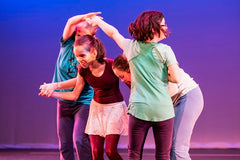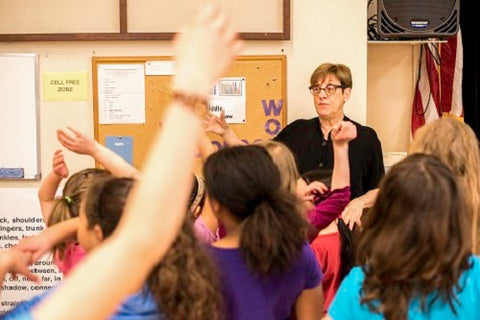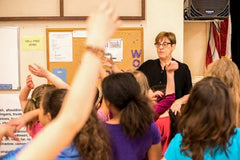Fostering Creativity in Dance Technique Class
By Anne Green Gilbert, Founder of Creative Dance Center and the Summer Dance Institute for Teachers
NOVEMBER 2019
When we foster creativity in dance technique classes, we help develop the next generation of innovative choreographers, fluent dance writers, and curious dance audience members. Creativity requires flexibility, imagination, problem solving, and risk taking. Creative people form original ideas through exploration and discovery. They imagine things that do not exist and come up with new ideas. Dance classes traditionally focus mastering steps, memorizing combinations of movement, and replicating positions and forms. However, with a few simple tools, teachers can foster creativity while developing skilled dancers.
 Start class with a neurodevelopmental warm-up such as BrainDance. An understanding of the developmental patterns helps dancers become more articulate and expressive, both physically and verbally, because these patterns are an integral part of every dance style. The patterns also provide a new entry point for teaching the mechanics of steps and movement. Embodying the patterns strengthens technique. Varying the developmental warm-up fosters creativity. Explore the patterns on different levels, use a variety of spatial directions, vary the rhythm and speed, and change the accompaniment by exploring verbal cues, music cues, rhymes, and silence. Imagination and risk taking are strengthened when partners take turns leading the warm-up for each other. To increase fluency, ask your students for ideas.
Start class with a neurodevelopmental warm-up such as BrainDance. An understanding of the developmental patterns helps dancers become more articulate and expressive, both physically and verbally, because these patterns are an integral part of every dance style. The patterns also provide a new entry point for teaching the mechanics of steps and movement. Embodying the patterns strengthens technique. Varying the developmental warm-up fosters creativity. Explore the patterns on different levels, use a variety of spatial directions, vary the rhythm and speed, and change the accompaniment by exploring verbal cues, music cues, rhymes, and silence. Imagination and risk taking are strengthened when partners take turns leading the warm-up for each other. To increase fluency, ask your students for ideas.
As you continue class, allow the dancers to recuperate from long combinations of steps by doing a 32-count structured improvisation. Cue them to move away from the barre (or their place on the floor) with strong movements and return with light movements, to move away in curved pathways and return in zigzag pathways, to explore movements that rise and sink and grow and shrink, to move in a backward direction and return in a sideways direction, to let one body part lead them away and a different part bring them back, or to shadow a partner’s movement through space and then change leaders on the return. Focusing on different elements (space, time, force, or body) in each class provides support for the dancers’ improvisation. Layering on new vocabulary each week develops creative complexity.
Over the course of a year, as you choreograph routines for the dancers, use different choreographic forms and devices and explain them to your students. By modeling creative thinking, you encourage creativity in your students.

Asking dancers to reflect on their feelings, knowledge base, and development of skills through various modes encourages curiosity and self-awareness. Reflection can take the form of a movement or shape following an improvisation, brief verbal sharing with a peer, journaling, or drawing.
Fostering creativity in dance classes strengthens social and emotional skills and develops imagination, flexibility, and risk taking. The world needs creative problem solvers. You can be part of the solution!
 Anne Green Gilbert has taught toddlers through adults at the Creative Dance Center, which she founded, as well as at elementary schools, universities, and at her Summer Dance Institute. She developed BrainDance in 2008 and this focusing warm-up exercise has been used around the world. She is the author of both Brain-Compatible Dance Education, Second Edition, and Creative Dance for All Ages, Second Edition. When Anne isn’t writing books or teaching others about BrainDance, she enjoys spending time with her family, including six dancing grandchildren.
Anne Green Gilbert has taught toddlers through adults at the Creative Dance Center, which she founded, as well as at elementary schools, universities, and at her Summer Dance Institute. She developed BrainDance in 2008 and this focusing warm-up exercise has been used around the world. She is the author of both Brain-Compatible Dance Education, Second Edition, and Creative Dance for All Ages, Second Edition. When Anne isn’t writing books or teaching others about BrainDance, she enjoys spending time with her family, including six dancing grandchildren.

Latest Posts
- Incorporating Musical Learning into Beginning Dance Classes - Part 2
- Incorporating musical learning into beginning dance classes
- Celebrating the dance contributions of women dancers
- Review of Essentials of Dance Psychology by Dr. Jenny Seham
- Inspiring Creativity - External Focus of Attention in Practice
- Review of Music Education for Dancers Online Course


